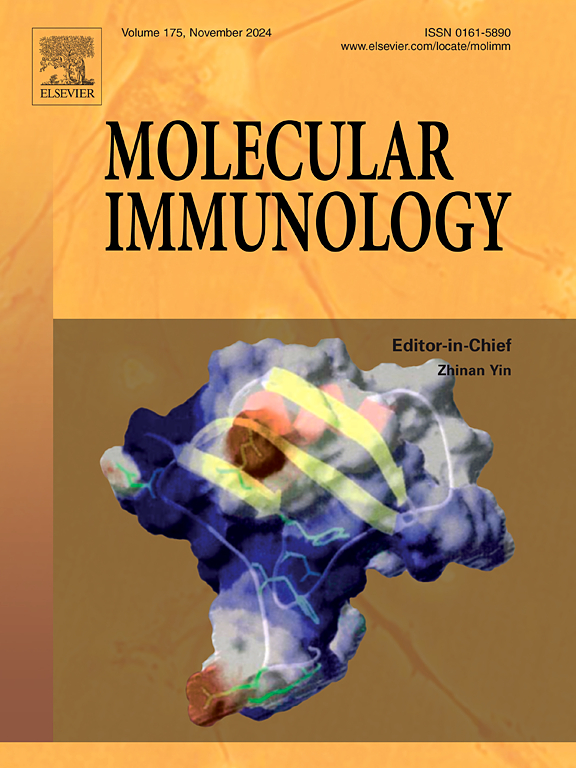UBE2I缺失通过糖酵解重编程调控肿瘤相关巨噬细胞向M1型极化,提高抗pd - l1在卵巢癌中的免疫治疗效果
IF 3.2
3区 医学
Q2 BIOCHEMISTRY & MOLECULAR BIOLOGY
引用次数: 0
摘要
有充分的证据表明,泛素结合酶E2I (UBE2I)参与多种癌症的进展。然而,UBE2I对卵巢癌(OC)的影响报道甚少。本研究试图发现UBE2I在OC中的作用机制和功能。通过qRT-PCR检测UBE2I、CD86、iNOS、MHC II和程序性死亡配体1 (PD-L1) mRNA的相对表达量。通过免疫组化染色检测肿瘤组织中UBE2I、Vimentin、E-Cadherin、N-Cadherin和Ki67蛋白的表达水平。western blot检测UBE2I、cleaved caspase-3、cleaved PARP、E-cadherin、N-cadherin、Vimentin蛋白水平。通过细胞计数试剂盒-8 (CCK-8)、transwell和伤口愈合试验检测细胞活力、侵袭和迁移。免疫荧光检测UBE2I与CD68的共定位。我们通过流式细胞术和ELISA检测IFN-γ和TNF-α的表达水平。我们采用TUNEL法评估肿瘤细胞凋亡。通过葡萄糖的消耗、ATP的产生、乳酸的产生和细胞外酸化速率来评估糖酵解。为了建立异种移植物模型,将OC细胞皮下注射到小鼠体内。UBE2I在OC细胞和组织中的表达增强,与OC患者的预后呈负相关。沉默UBE2I可抑制OC细胞的增殖、侵袭、上皮-间质转化(EMT)和迁移。UBE2I抑制促进巨噬细胞M1表型和巨噬细胞活力。在体内缺失UBE2I后,小鼠肿瘤生长和EMT受到抑制,肿瘤细胞凋亡增加。同时,在UBE2I缺失后,CD86+ tam(肿瘤相关巨噬细胞)的比例增加。此外,通过沉默UBE2I,观察到THP-1细胞中葡萄糖消耗、乳酸生成、ATP生成和ECAR的增加;然而,糖酵解抑制剂以剂量依赖性的方式逆转ube2i介导的M1巨噬细胞极化。重要的是,ube2i介导的M1巨噬细胞促进了PD-L1的表达。此外,UBE2I抑制剂与抗pd -1联合治疗可抑制肿瘤生长,降低Ki67表达,促进肿瘤细胞凋亡,效果优于UBE2I抑制剂/抗pd - l1单独治疗。UBE2I抑制通过糖酵解调节M1巨噬细胞极化,提高抗pd - l1免疫治疗效果,为预防OC发展开辟了新的途径。本文章由计算机程序翻译,如有差异,请以英文原文为准。
UBE2I depletion regulated tumor-associated macrophage polarization into M1 type through reprogramming glycolysis and increases immunotherapy efficacy of anti-PD-L1 in ovarian cancer
There is ample evidence that ubiquitin-conjugating enzyme E2I (UBE2I) is involved in progression of diverse cancers. However, the influence of UBE2I on ovarian cancer (OC) has been poorly reported. This study tries to discover the mechanisms and functions of UBE2I in OC. Relative mRNA expression of UBE2I, CD86, iNOS, MHC II and programmed death ligand 1 (PD-L1) was detected through qRT-PCR. We identified UBE2I, Vimentin, E-Cadherin, N-Cadherin and Ki67 protein expression levels in tumor tissues through immunohistochemistry staining. Protein levels of UBE2I, cleaved caspase-3, cleaved PARP, E-cadherin, N-cadherin and Vimentin were detected through western blot. Cell viability, invasion, and migration were examined by means of cell counting kit-8 (CCK-8), transwell, and wound healing assays. Immunofluorescence was used to detect colocalization between UBE2I and CD68. We assessed expression levels of IFN-γ and TNF-α via flow cytometry and ELISA. We used the TUNEL assay to assess tumor cell apoptosis. Glycolysis was assessed through the consumption of glucose, ATP production, production of lactate, and extracellular acidification rate. For establishing a xenograft model, OC cells were subcutaneously injected into mice. UBE2I expression was boosted in OC cells and tissues, which was negatively associated with OC patients’ prognosis. Silencing of UBE2I suppressed OC cell proliferation, invasion, EMT (epithelial-to-mesenchymal transition) and migration. UBE2I inhibition promoted macrophages toward the M1 phenotype and macrophage viability. After deletion of UBE2I in vivo, mice tumor growth and EMT were suppressed, and apoptosis of tumor cells was increased. Meantime, an increasing proportion of CD86+ TAMs (tumor-associated macrophages) was observed after the deletion of UBE2I. Besides, increases in consumption of glucose, lactate production, ATP production and ECAR in THP-1 cells were observed by silencing of UBE2I; however, glycolysis inhibitor reversed UBE2I-mediated polarization of M1 macrophages in a dose-dependent fashion. Importantly, UBE2I-mediated M1 macrophages promoted PD-L1 expression. Furthermore, the combinatorial therapy of UBE2I inhibitor plus anti-PD-1 repressed tumor growth, reduced Ki67 expression, and promoted apoptosis in tumor cells, exhibiting higher efficiency than UBE2I inhibitor/anti-PD-L1 alone. UBE2I inhibition regulated polarization of M1 macrophages via glycolysis and improved anti-PD-L1 immunotherapy efficacy, paving a novel avenue to prevent OC development.
求助全文
通过发布文献求助,成功后即可免费获取论文全文。
去求助
来源期刊

Molecular immunology
医学-免疫学
CiteScore
6.90
自引率
2.80%
发文量
324
审稿时长
50 days
期刊介绍:
Molecular Immunology publishes original articles, reviews and commentaries on all areas of immunology, with a particular focus on description of cellular, biochemical or genetic mechanisms underlying immunological phenomena. Studies on all model organisms, from invertebrates to humans, are suitable. Examples include, but are not restricted to:
Infection, autoimmunity, transplantation, immunodeficiencies, inflammation and tumor immunology
Mechanisms of induction, regulation and termination of innate and adaptive immunity
Intercellular communication, cooperation and regulation
Intracellular mechanisms of immunity (endocytosis, protein trafficking, pathogen recognition, antigen presentation, etc)
Mechanisms of action of the cells and molecules of the immune system
Structural analysis
Development of the immune system
Comparative immunology and evolution of the immune system
"Omics" studies and bioinformatics
Vaccines, biotechnology and therapeutic manipulation of the immune system (therapeutic antibodies, cytokines, cellular therapies, etc)
Technical developments.
 求助内容:
求助内容: 应助结果提醒方式:
应助结果提醒方式:


